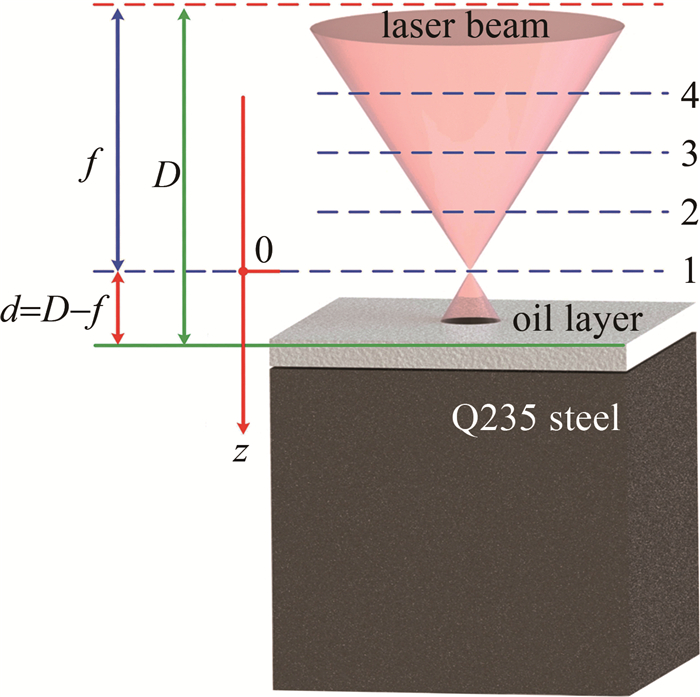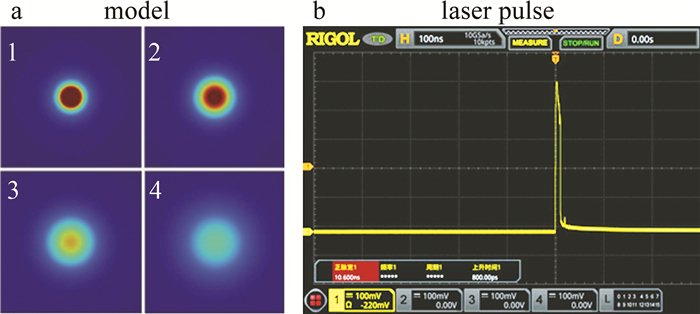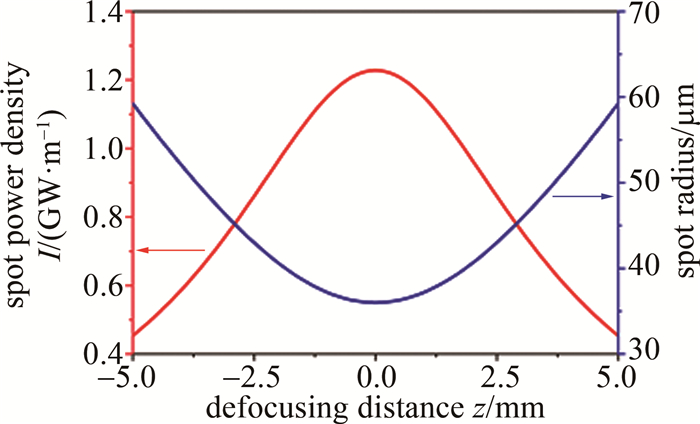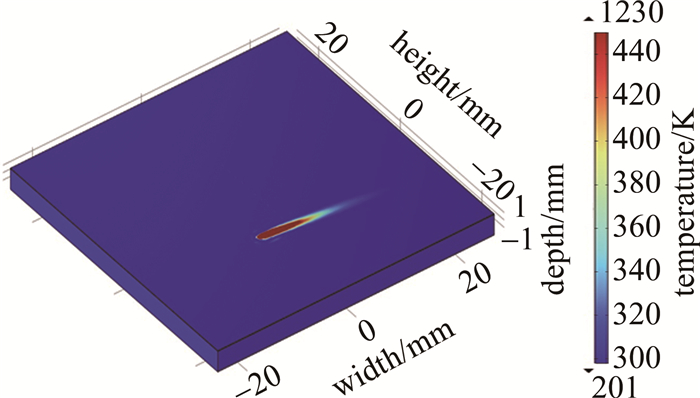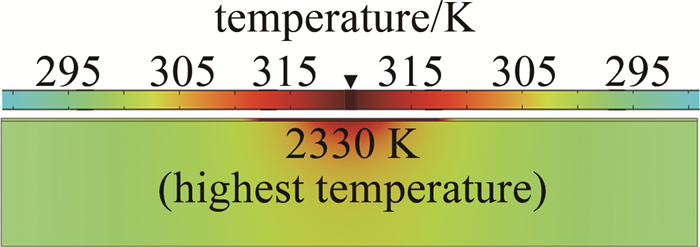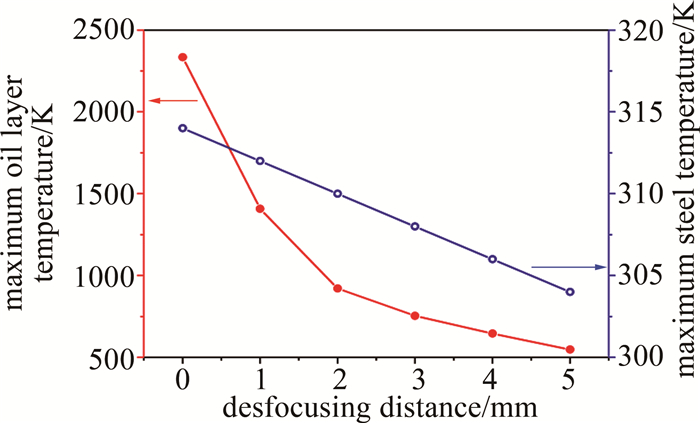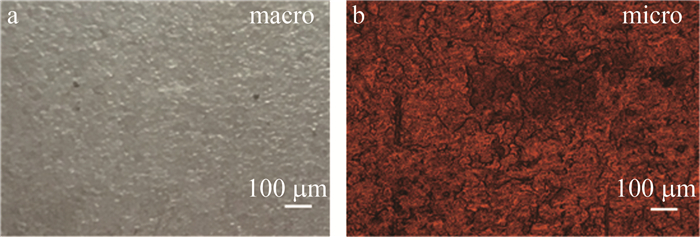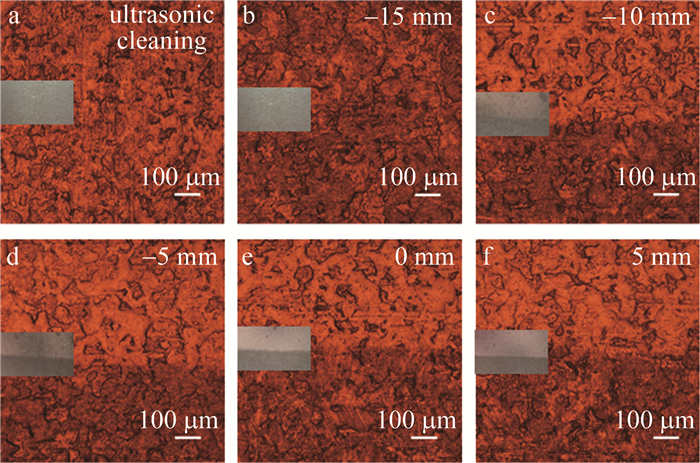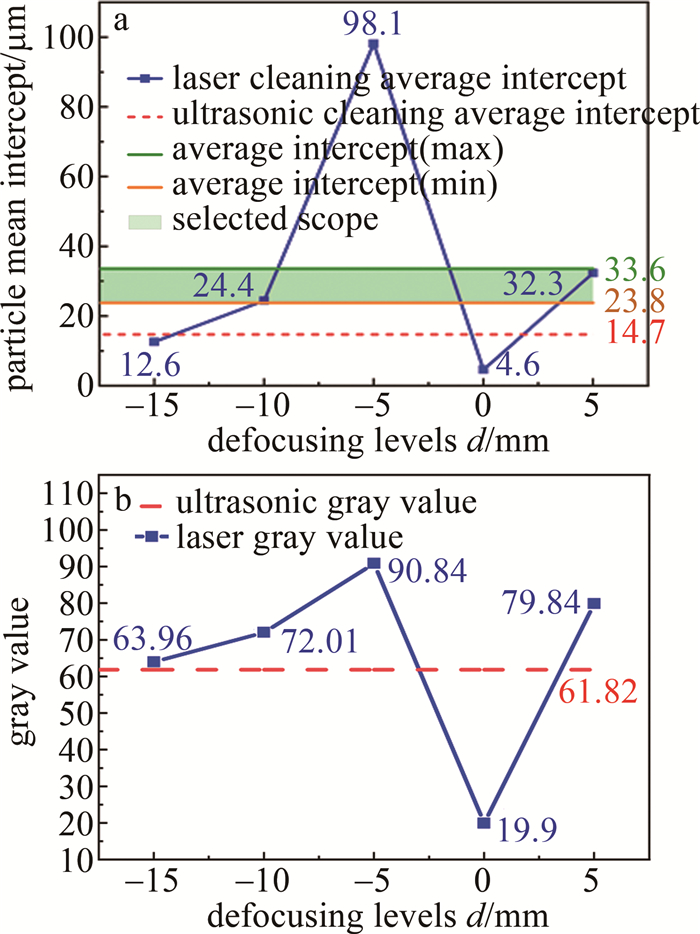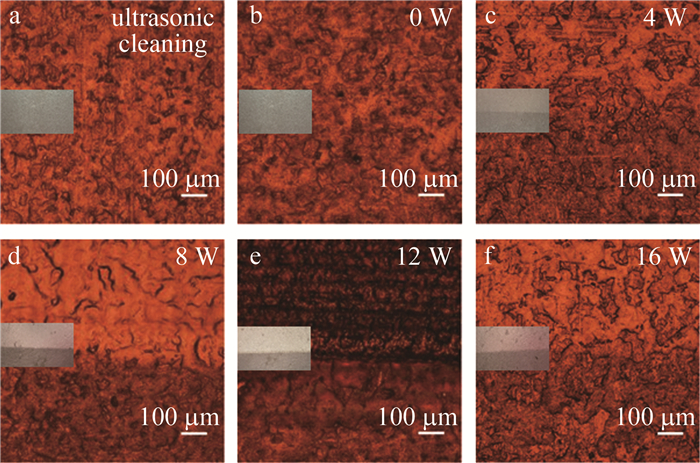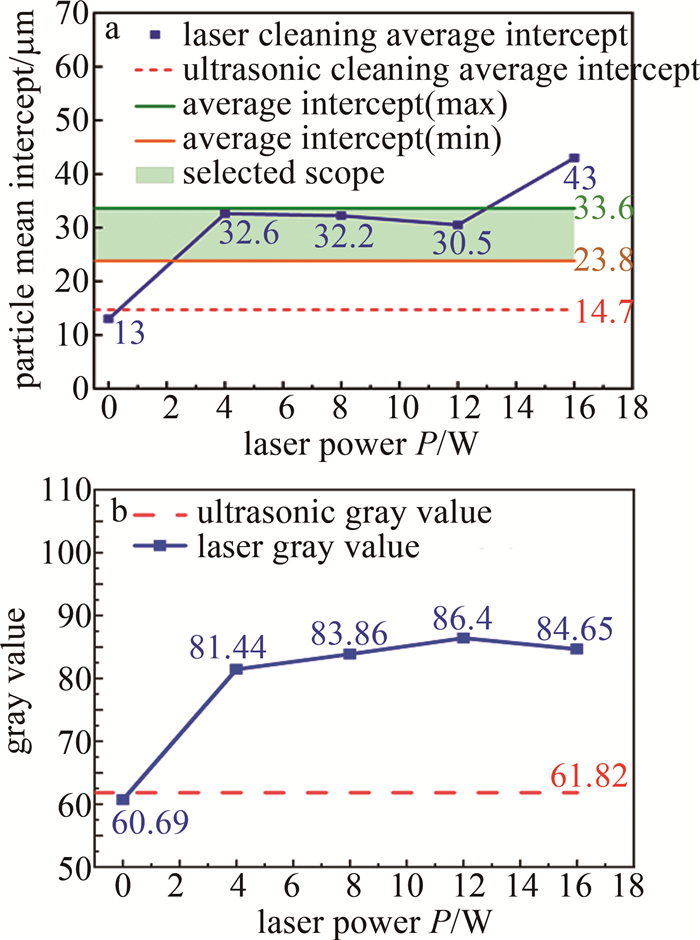Technological study on oil stains on steel surface by laser cleaning
-
摘要: 为了探究激光工艺对钢件表面油污层清洗质量的影响规律,采用脉冲激光器对Q235钢板试样进行了激光除污清洗试验, 并检测了试样表面清洗质量和损伤情况。理论分析了清洗过程中激光束对油污层和基体钢件作用的机理与效果,建立了激光热效应模型,通过仿真计算与实验,分析出离焦程度对基体表面温度的影响程度;实验验证了激光清洗工艺中不同离焦程度下对Q235钢件表面油污的去除效果和钢件表面的损伤效果。结果表明,激光清洗Q235钢件表面油污层的最优工艺参数是离焦程度为5 mm,平均功率为4 W,可见离焦程度因素对清洗效果的影响远大于激光功率因素。该研究为金属表面油污处理工艺和激光清洗提供了一定参考。Abstract: In order to investigate the influence of laser process on the cleaning quality of oil contamination layer on the surface of steel parts, a laser decontamination cleaning test was carried out on a Q235 steel plate specimen by using a pulsed laser, and the cleaning quality and damage of the specimen surface were detected. The mechanism and effect of the laser beam on the oil contamination layer and substrate steel in the cleaning process were theoretically analyzed, a laser thermal effect model was established, and the influence of the degree of defocusing on the surface temperature of the substrate through simulation calculation and test were analyzed. The removal effect of oil contamination on the surface of Q235 steel parts and the damage effect on the surface of steel parts under different defocusing degree in the laser cleaning process were respectively verified by the test. The results show that the optimal process parameters of laser cleaning of oil contamination layer on the surface of Q235 steel parts is that the defocusing degree is 5 mm, and the average power is 4 W. The influence of defocusing degree on the cleaning effect is much bigger than that of the laser power factor. This study provides some reference for the oil treatment process and laser cleaning of metal surfaces.
-
Keywords:
- laser technique /
- laser cleaning /
- degreasing /
- Q235 steel /
- nondestructive cleaning /
- laser parametric
-
引言
周期性纳米结构滤光片对入射光的吸收率较小,其中心光谱位置、带宽等性能参量均可由结构参量进行调节,且易于集成,已成为彩色滤光片重要的研究和应用方向之一[1]。研究表明,当光栅周期远小于入射光波长时,只产生0级衍射光波,而其它较高级次的衍射光均为倏逝波,这类光栅称为亚波长光栅。通过调整亚波长光栅的取向、周期、深度等,对光选择性透射(反射/吸收),在光显示、光伏、光传感、光检测和无油墨印刷等领域的应用引起了广泛关注[2]。如果在液晶显示屏(liquid crystal display,LCD)中采用纳米光栅结构滤光片替代颜料型彩色滤光片,应满足以下要求:光能利用率高,透射带宽适中,旁带透射率低。中国专利“混合型偏振片及其制造方法和具有其的显示装置”中提出了一种埋入式单层金属光栅彩色滤光片[3],该彩色滤光片由位于基底上多个区域的不同周期、不同占空比、不同高度的金属光栅组成。
随着纳米加工技术的发展,导模共振滤光片以其设计结构简单、衍射效率高、半峰全宽(带宽)窄等优点引起了越来越多的关注。但大部分研究都是基于介质光栅的导模共振特性得到反射滤光片,基于表面等离子体效应的金属光栅的研究较少[3-5]。当光入射到金属光栅表面时,由于光子与金属表面自由电子的电荷密度波耦合成表面等离子体(surface plasmons,SP)在特定的光波长内表现出透射增强现象,这种现象称为表面等离子体效应。
目前,想要得到特定波长的滤光片,设计光栅结构,大多采用严格耦合波分析、模式法和时域有限差分等方法数值分析光栅周期、占空比、厚度等参量变化对透射谱线的影响,进而得到参量的优化范围[6]。本文中提出利用粒子群优化(particle swarm optimization, PSO)算法与严格耦合波分析(rigorous coupled wave analysis, RCWA)方法结合,在给定滤光波长要求的情况下,逆优化结构参量。粒子群优化是一种由一群鸟类和昆虫群的社会行为启发的进化计算技术。最初由KENNEDY和EBERHART提出,近年来主要应用于电磁场优化问题[7-8]。由于在各种问题中实现方便并且具有强大的优化能力,PSO算法越来越引起研究人员的注意。
本文中把光栅结构的参量作为优化的粒子,在一定范围内不断改变粒子的速度和位置,设定目标函数计算适应值F,对每组优化粒子进行评估,最终找到全局最优解。
1. 理论分析
本文中研究一种基底-高折射率光栅-金属光栅的透射式滤光片结构,如图 1所示。金属光栅层材料为Al,折射率为nm,色散曲线依照Drude模型[9-11]。高折射率介质光栅层折射率nd=2.4,基底层折射率ns=1.5,Λ代表光栅的周期,光栅的宽度W=Λf,f为光栅的占空比,金属光栅层的厚度为dm,介质光栅的厚度为dd。当TM光从光栅表面垂直入射,金属表面发生等离子体共振。在金属和基底之间增加高折射率介质光栅层,满足波导共振激发条件,发生导模共振。由于这两种效应的共同作用,在特定波长发生透射增强。
2013年,ZHOU[2]提出当结构中的金属光栅厚度dm=0.06μm,介质光栅厚度dd=0.08μm,占空比f=0.75,周期Λ=0.4μm时,光谱峰值位置波长为0.65μm,透射效率为67%。为了提高光栅结构滤光片对波长为0.65μm红光的透射效率,缩小带宽,本文中提出利用PSO算法,逆优化结构参量。
在PSO中,群体的每个粒子被认为是N维搜索空间中的一个无质量的点,粒子仅具有两个属性:位置X和速度v,位置代表粒子移动的方向,速度代表粒子移动的快慢。每个粒子在搜索空间中寻找最优解,将其记为当前个体极值Pm,并将个体极值与整个粒子群里的其他粒子共享,找到最优的那个个体极值作为整个粒子群的当前全局最优解G,粒子群中的所有粒子根据自己找到的当前个体极值Pm和整个粒子群共享的当前全局最优解G来调整自己的速度和位置,直到输出全局最优解[12-14]。速度和位置的迭代公式为:
\begin{array}{l} {\mathit{\boldsymbol{v}}_{m, k + 1}} = \mathit{\boldsymbol{\omega }}{\mathit{\boldsymbol{v}}_{m, k}} + {c_1}{\rm{ran}}{{\rm{d}}_1}\left( {} \right)\left( {{\mathit{\boldsymbol{P}}_\mathit{m}} - {\mathit{\boldsymbol{X}}_{m, k}}} \right) + \\ \;\;\;\;\;\;\;\;\;\;\;\;\;\;\;\;{c_2}{\rm{ran}}{{\rm{d}}_2}\left( {\mathit{\boldsymbol{G - }}{\mathit{\boldsymbol{X}}_{m, k}}} \right) \end{array} (1) {\mathit{\boldsymbol{X}}_{m, k + 1}} = {\mathit{\boldsymbol{X}}_{m, k}} + {\mathit{\boldsymbol{v}}_{m, k + 1}}\Delta \mathit{t} (2) 式中,ω是惯性权重,设定为从0.9~0.4递减,c1和c2设为1.49,Δt为时间步长,设为1,参量设置参见参考文献[15],rand( )为MATLAB自带函数,返回一个0~1之间的随机数,当前个体极值Pm={p1m, p2m, …, pnm},n=20, G=Pm,Pm和G迭代规则为:如果F(Xm, k+1)比F(Pm)小,则Pm由Xm, k+1取代。如果F(Pm)比F(G)小,则G被Pm取代。直到迭代结束。
对于通过PSO设计的金属光栅滤光片,本文中选择透射波长0.65μm的红光,选择4个参量作为优化参量:光栅厚度dm,介质层厚度dd,光栅周期Λ和占空比f。因此,粒子群数组为X={Λ,dm,dd,f}。设定目标函数,求适应值F公式如下[16]:
F = {\left\{ {\frac{1}{M}\sum\limits_{{\mathit{\lambda }_\mathit{i}}} {{{\left[ {{\mathit{R}_{\rm{t}}}\left( \mathit{\lambda } \right) - {R_{\rm{d}}}\left( \mathit{\lambda } \right)} \right]}^2}} } \right\}^{1/2}} (3) 式中,Rt是不同波长入射光期望达到的透射效率,为了实现红光透射效率高、旁带低的要求,这里设定波长为0.65μm的透射效率达到最大值,此时最大值为1,带宽控制在小于50nm,设定波长为0.625μm和0.675μm时透射效率为0.3,其它波长对应透射效率设为0, 以减小旁带。Rd是把PSO中的优化参量代入RCWA程序计算所得到的透射效率,M是所取波长点的数量。粒子的F为两者的方差,反映了优化的程度,F越小,Rt越接近Rd,就越符合优化的结果。
2. 建模与仿真
在MATLAB中进行仿真,仿真流程见图 2。在PSO程序模块中,首先分配粒子群中待定参量的初始数量,仿真过程中设定为20。参量的范围为:0μm < Λ < 0.650μm; 0μm < dm, dd < 0.500μm; 0 < f0.99;在范围内随机产生粒子的初始速度和位置。在RCWA程序中对图 1结构建模,设定基底、介质和金属材料,把PSO中随机产生的20组参量记为当前的个体极值,并分别代入到RCWA程序计算各组参量对应结构对各波长光的透射效率,根据(3)式,把RCWA程序获得的透射效率与设定曲线的透射效率代入到计算适应值的程序中, 得到这20组随机参量的适应值,把适应值最小的一组参量记为当前的全局最优解。根据迭代(1)式和(2)式,更新结构参量,重新代入RCWA程序,并计算适应值,比较每组参量迭代后的适应值与当前的个体极值,更新个体极值和全局最优解。重复以上流程,这里设定重复执行6000次,迭代次数足够多以确保适应值稳定且收敛[17-19]。
3. 优化结果与分析
针对透射波长0.65μm的红光滤光片,图 3为PSO适应值随迭代次数变化的曲线。得到优化参量为:Λ=0.300μm,dm=0.035μm,dd=0.400μm,f=0.77,根据得到的最优参量模拟其对应结构透射效率随波长的变化曲线Rd(λ)与设定的透射效率曲线Rt(λ)的比较, 如图 4所示。设置虚线为目标曲线,实线为PSO优化结构的仿真曲线,点线为参考文献中ZHOU提出的结构透射光谱。
![Figure 4. Relationship between transmission spectra of grating structure[2], the optimal structure and the target and wavelength]() Figure 4. Relationship between transmission spectra of grating structure[2], the optimal structure and the target and wavelength
Figure 4. Relationship between transmission spectra of grating structure[2], the optimal structure and the target and wavelength根据PSO算法得出的适应值随迭代次数变化图,以及最优结构透射效率随波长变化曲线与设定曲线对比的图形分析可知,迭代过程中适应值逐渐收敛,大约在2000次后趋于稳定,迭代6000次后得到适应值仅为0.0728,优化了结构参量,优化参量对应的光栅结构对红光透射率达到了80.27%,旁带效率控制在15%以内,半峰全宽(full width at half maximum,FWHM)仅为30nm。与ZHOU提出的结构透射光谱对比可知,此优化结构提高了透射效率,缩小了带宽。
在最优参量的基础上,通过改变单一参量,得到周期Λ、占空比f、金属光栅高度dm和介质光栅高度dd变化对透射效率的影响。图 5a中为当f=0.77,dm=0.035μm,dd=0.400μm,周期Λ分别为0.280μm, 0.290μm, 0.300μm, 0.310μm, 0.320μm时光栅结构对不同波长光的透射效率曲线。图 5b~图 5d中为固定其它参量,分别改变f, dm,dd时透射效率随波长变化的曲线。
由分析可知,图 5a中, 当固定其它参量改变周期Λ时,随着Λ的变大,曲线红移,透射效率减小,周期小于最优值时,旁带大于20%,不能应用于整个可见光波段,周期大于最优值时,透射效率下降明显。图 5b中,当固定其它参量改变金属光栅厚度dm时,同样出现厚度小于最优值时,旁带超过20%,大于最优值时,透射效率显著下降。图 5c中,随着介质光栅厚度dd的增大,旁带透射效率也增大,厚度小于最优值时效率较低。图 5d中,随着占空比f的增大,曲线红移,在取最优值时旁带效率和透射效率与取其它值相比更优。因此,由PSO算法得出的最优结构实现了特定波长光的高效率透射。
4. 结论
将粒子群优化(PSO)算法应用到求解高效率透射光栅结构的结构参量上,利用MATLAB进行仿真,通过设定目标函数控制透射效率、旁带效率和带宽,不断迭代,比较适应值,使得仿真曲线与设定曲线的差值最小,实现了对光栅周期、占空比、光栅厚度、介质厚度的优化,优化结构对应的透射效率曲线在波长为0.65μm时达到最大,旁带效率小于15%,半峰全宽仅为30nm。在得到优化参量的基础上,分析了改变各个参量对透射效率的影响。研究表明,该亚波长金属-介质光栅滤光片结构实现了对波长为0.65μm红光的高效率透射。
-
-
[1] 潘邻. 激光表面改性技术的现状与展望[J]. 表面工程资讯, 2005, 5(1): 5-6. https://www.cnki.com.cn/Article/CJFDTOTAL-BMZX200501002.htm PAN L. Current status and prospect of laser surface modification technology[J]. Surface Engineering Information, 2005, 5(1): 5-6(in Chinese). https://www.cnki.com.cn/Article/CJFDTOTAL-BMZX200501002.htm
[2] 宋峰, 陈铭军, 陈晅, 等. 激光清洗研究综述(特邀)[J]. 红外与激光工程, 2023, 52(2): 20220835. https://www.cnki.com.cn/Article/CJFDTOTAL-HWYJ202302004.htm SONG F, CHEN M J, CHEN Y, et al. Review of laser cleaning research(invited)[J]. Infrared and Laser Engineering, 2023, 52(2): 20220835(in Chinese). https://www.cnki.com.cn/Article/CJFDTOTAL-HWYJ202302004.htm
[3] LI Y H, LI J Y, DONG H, et al. Mechanism of paint removal by nanosecond pulsed laser lasma shock: Simulation and experiment[J]. Applied Optics, 2023, 62(11): 2855-2861. DOI: 10.1364/AO.484609
[4] 张志研, 王奕博, 梁浩, 等. 高重复频率脉冲激光去除低热导率涂漆[J]. 中国激光, 2019, 46(1): 0102009. https://www.cnki.com.cn/Article/CJFDTOTAL-JJZZ201901019.htm ZHANG Zh Y, WANG Y B, LIANG H, et al. Removal of low thermal conductivity paint with high repetition rate pulse laser[J]. Chinese Journal of Lasers, 2019, 46(1): 0102009(in Chinese). https://www.cnki.com.cn/Article/CJFDTOTAL-JJZZ201901019.htm
[5] 江宇宏, 何玉洋, 符永宏, 等. 激光清洗技术规模化应用发展现状(特邀)[J]. 红外与激光工程, 2023, 52(2): 20220753. https://www.cnki.com.cn/Article/CJFDTOTAL-HWYJ202302007.htm JIANG Y H, HE Y Y, FU Y H, et al. Development status of large-scale application of laser cleaning technology (invited)[J]. Infrared and Laser Engineering, 2023, 52(2): 20220753(in Chinese). https://www.cnki.com.cn/Article/CJFDTOTAL-HWYJ202302007.htm
[6] 李悦, 吴卓颐, 储德谱, 等. 激光清洗监测技术研究进展(特邀)[J]. 红外与激光工程, 2023, 52(2): 20220784. https://www.cnki.com.cn/Article/CJFDTOTAL-HWYJ202302005.htm LI Y, WU Zh Y, CHU D P, et al. Research progress of laser cleaning monitoring technology (invited)[J]. Infrared and Laser Engineering, 2023, 52(2): 20220784(in Chinese). https://www.cnki.com.cn/Article/CJFDTOTAL-HWYJ202302005.htm
[7] 李浩宇, 杨峰, 郭嘉伟, 等. 激光清洗的发展现状与前景[J]. 激光技术, 2021, 45(5): 654-661. DOI: 10.7510/jgjs.issn.1001-3806.2021.05.020 LI H Y, YANG F, GUO J W, et al. Development status and prospect of laser cleaning[J]. Laser Technology, 2021, 45(5): 654-661(in Chinese). DOI: 10.7510/jgjs.issn.1001-3806.2021.05.020
[8] FANG B Y, LU L, DING M Zh, et al. Study on corrosion resistance of rust-preventive oil under shipment and storage conditions[J]. Baosteel Technical Research, 2015, 9(1): 24-32.
[9] VISWANATHAN S S. Temporary rust preventives—A retrospective[J]. Progress in Organic Coatings, 2020, 140(3): 105511.
[10] 陈波, 魏焕君, 耿志宇, 等. 热成形钢的脱碳影响因素分析[J]. 金属热处理, 2021, 46(2): 161-167. https://www.cnki.com.cn/Article/CJFDTOTAL-JSRC202102033.htm CHEN B, WEI H J, GENG Zh Y, et al. Analysis on factors affecting decarburization of hot forming steel[J]. Heat Treatment of Metals, 2021, 46(2): 161-167(in Chinese). https://www.cnki.com.cn/Article/CJFDTOTAL-JSRC202102033.htm
[11] 张杰. 金属除油工艺的研究进展[J]. 山东化工, 2015, 44(21): 48-50. https://www.cnki.com.cn/Article/CJFDTOTAL-SDHG201521022.htm ZHANG J. The research progress of metal degreasing process[J]. Shandong Chemical Industry, 2015, 44(21): 48-50(in Chinese). https://www.cnki.com.cn/Article/CJFDTOTAL-SDHG201521022.htm
[12] JEROME L, BEGIN D, GERIN M M. Technical, occupational health and environmental aspects of metal degreasing with aqueous cleaners[J]. Annals of Work Exposures and Health, 2003, 47(6): 441-459.
[13] GOLSTEIJN L, HUIZER D, HAUCK M, et al. Including exposure variability in the life cycle impact assessment of indoor chemical emissions: The case of metal degreasing[J]. Environment International, 2014, 71(1): 36-45.
[14] RUBINO G, MARCONI M, BAIOCCO G, et al. Technical, environmental, and economic feasibility investigation of an innovative dry washing process for metal degreasing[J]. International Journal of Advanced Manufacturing Technology, 2022, 121(11): 7475-7492.
[15] 吴勇华, 任晓晨, 刘皓贤, 等. 激光参量对碳钢表面清洗质量的影响[J]. 激光技术, 2021, 45(4): 500-506. DOI: 10.7510/jgjs.issn.1001-3806.2021.04.014 WU Y H, REN X Ch, LIU H X, et al. Influences of laser parameters on the cleaning quality of carbon steel surface[J]. Laser Technology, 2021, 45(4): 500-506(in Chinese). DOI: 10.7510/jgjs.issn.1001-3806.2021.04.014
[16] 刘鹏宇, 王宪伦, 张则荣. 激光清洗的机理研究进展[J]. 工业加热, 2022, 51(10): 50-53. https://www.cnki.com.cn/Article/CJFDTOTAL-GYJR202210012.htm LⅡU P Y, WANG X L, ZHANG Z R. Research progress on the mechanism of laser cleaning[J]. Industrial Heating, 2022, 51(10): 50-53(in Chinese). https://www.cnki.com.cn/Article/CJFDTOTAL-GYJR202210012.htm
[17] 赵海朝, 乔玉林, 杜娴, 等. 能量密度对激光清洗铝合金漆层的影响及作用机理[J]. 激光与光电子学进展, 2020, 57(13): 131403. https://www.cnki.com.cn/Article/CJFDTOTAL-JGDJ202013023.htm ZHAO H Ch, QIAO Y L, DU X, et al. Effect and mechanism of energy density on the aluminum alloy paint cleaned by laser[J]. Laser & Optoelectronics Progress, 2020, 57(13): 131403(in Chinese). https://www.cnki.com.cn/Article/CJFDTOTAL-JGDJ202013023.htm
[18] 单腾, 王思捷, 殷凤仕, 等. 激光清洗的典型应用及对基体表面完整性影响的研究进展[J]. 材料导报, 2021, 35(11): 11163-11172. https://www.cnki.com.cn/Article/CJFDTOTAL-CLDB202111019.htm SHAN T, WANG S J, YIN F Sh, et al. A review of the application of laser cleaning and its influences on the substrate surface integrity[J]. Materials Reports, 2021, 35(11): 11163-11172(in Chinese). https://www.cnki.com.cn/Article/CJFDTOTAL-CLDB202111019.htm
[19] 郭嘉伟, 蔡和, 韩聚洪, 等. 基于热烧蚀效应的激光清洗仿真模型研究[J]. 红外与激光工程, 2023, 52(2): 20220779. https://www.cnki.com.cn/Article/CJFDTOTAL-HWYJ202302013.htm GUO J W, CAI H, HAN J H, et al. Simulation model of laser cleaning based on thermally-induced ablation effects (invited)[J]. Infrared and Laser Engineering, 2023, 52(2): 20220779(in Chinese). https://www.cnki.com.cn/Article/CJFDTOTAL-HWYJ202302013.htm
[20] 王宝同, 王邦文, 贾爱红, 等. 中厚板控冷过程三维温度场的数值模拟[J]. 冶金设备, 2005, 6(12): 10-13. https://www.cnki.com.cn/Article/CJFDTOTAL-YJSB200506002.htm WANG B T, WANG B W, JIA A H, et al. Numerical simulation of three-dimensional temperature field in controlled cooling process of medium-thick plate[J]. Metallurgical Equipment, 2005, 6(12): 10-13(in Chinese). https://www.cnki.com.cn/Article/CJFDTOTAL-YJSB200506002.htm
[21] 余万华, 张中平. 热轧钢板在加速冷却时的温度模型[J]. 北京科技大学学报, 2005, 27(5): 567-570. https://www.cnki.com.cn/Article/CJFDTOTAL-BJKD200505014.htm YU W H, ZHANG Zh P. Temperature modeling of hot rolled steel plates during accelerated cooling[J]. Journal of University of Science and Rechnology Beijing, 2005, 27(5): 567-570(in Chinese). https://www.cnki.com.cn/Article/CJFDTOTAL-BJKD200505014.htm
[22] 王生朝, 孙斌. Q345C钢连铸板坯热送热装过程中温度场和应力场模拟[J]. 特殊钢, 2016, 37(1): 13-16. https://www.cnki.com.cn/Article/CJFDTOTAL-TSGA201601005.htm WANG Sh Ch, SUN B. Simulation of temperature and stress fields during hot feeding and hot loading of Q345C steel continuous casting slabs[J]. Special Steel, 2016, 37(1): 13-16(in Chinese). https://www.cnki.com.cn/Article/CJFDTOTAL-TSGA201601005.htm
[23] 鄂红军, 朱和菊, 胡磊磊, 等. DSC法测定润滑油基础油比热容的研究[J]. 石油商技, 2015, 33(6): 80-83. https://www.cnki.com.cn/Article/CJFDTOTAL-SYSA201506018.htm E H J, ZHU H J, HU L L, et al. Determination of specific heat capacity of lubricant base oil by DSC method[J]. Petroleum Commerce and Technology, 2015, 33(6): 80-83 (in Chinese). https://www.cnki.com.cn/Article/CJFDTOTAL-SYSA201506018.htm
[24] 杜仲星, 谷波, 田镇, 等. R32及PVE润滑油混合物密度、比热容和黏度计算模型与分析[J]. 流体机械, 2022, 50(7): 44-49. https://www.cnki.com.cn/Article/CJFDTOTAL-LTJX202207007.htm DU Zh X, GU B, TIAN Zh, et al. Modeling and analysis of density, specific heat capacity and viscosity calculations for R32 and PVE lubricant blends[J]. Fluid Machinery, 2022, 50(7): 44-49(in Chinese). https://www.cnki.com.cn/Article/CJFDTOTAL-LTJX202207007.htm
[25] 程丽杰, 栾燕, 谷强, 等. 金属平均晶粒度测定方法: GB/T6394-2017[S]. 北京: 中华人民共和国国家标准, 2017: 5-17(in Chinese). CHENG L J, LUAN Y, GU Q, et al. Measurement of metal-averaged particle mean intercept: GB/T6394-2017[S]. Beijing: China Standard Press, 2017: 5-17(in Chinese).
[26] 崔桂彬, 鞠新华, 杨瑞, 等. 基于离子研磨技术的超低碳钢中铁素体晶粒的显示[J]. 理化检验(物理分册), 2021, 57(12): 8-11. https://www.cnki.com.cn/Article/CJFDTOTAL-LHJW202112002.htm CUI G B, JU X H, YANG R, et al. Display of ferrite grains in ultra-low carbon steelbased on ion milling technology[J]. Physical Testing and Chemical Analysis Part A: Physical Testing, 2021, 57(12): 8-11(in Chinese). https://www.cnki.com.cn/Article/CJFDTOTAL-LHJW202112002.htm
-
期刊类型引用(2)
1. 汤超龙,赵永强,刘芯羽. 基于蚁群算法的二维多层亚波长光栅结构设计. 红外与毫米波学报. 2022(04): 756-761 .  百度学术
百度学术
2. 安超,褚金奎,张然. 基于遗传算法的双层亚波长金属光栅优化. 激光与光电子学进展. 2019(22): 34-40 .  百度学术
百度学术
其他类型引用(5)




 下载:
下载:


![Figure 4. Relationship between transmission spectra of grating structure[2], the optimal structure and the target and wavelength](/fileJGJS/journal/article/jgjs/2024/4/jgjs-42-5-617-4.jpg)

